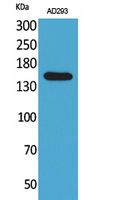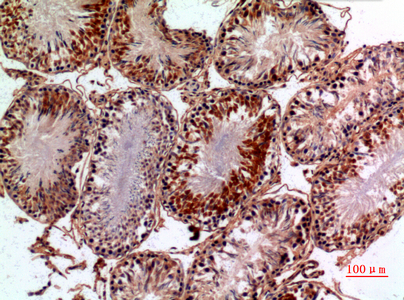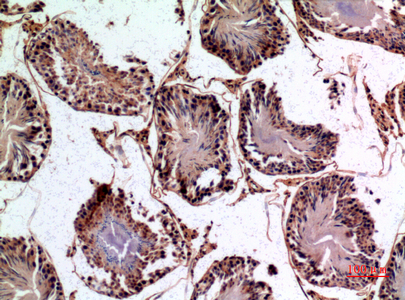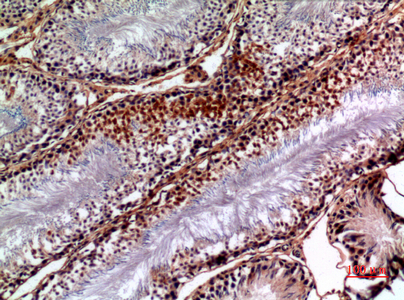



| WB | 咨询技术 | Human,Mouse,Rat |
| IF | 咨询技术 | Human,Mouse,Rat |
| IHC | 1/50-1/100 | Human,Mouse,Rat |
| ICC | 技术咨询 | Human,Mouse,Rat |
| FCM | 咨询技术 | Human,Mouse,Rat |
| Elisa | 1/10000 | Human,Mouse,Rat |
| Aliases | PNPLA6; NTE; Neuropathy target esterase; Patatin-like phospholipase domain-containing protein 6 |
| Entrez GeneID | 10908 |
| WB Predicted band size | Calculated MW: 151 kDa; Observed MW: 151 kDa |
| Host/Isotype | Rabbit IgG |
| Antibody Type | Primary antibody |
| Storage | Store at 4°C short term. Aliquot and store at -20°C long term. Avoid freeze/thaw cycles. |
| Species Reactivity | Human,Mouse,Rat |
| Immunogen | The antiserum was produced against synthesized peptide derived from the Internal region of human PNPLA6. AA range:1031-1080 |
| Formulation | Purified antibody in PBS with 0.05% sodium azide,0.5%BSA and 50% glycerol. |
+ +
以下是关于NTE(神经病靶标酯酶)抗体的3篇代表性文献的简要信息:
---
1. **文献名称**:*Neuropathy Target Esterase (NTE) in Nervous Tissue and Autoantibodies in Patients with Neurodegenerative Diseases*
**作者**:Johnson MK, Glynn P
**摘要**:该研究探讨了NTE在神经组织中的功能及其与有机磷中毒后迟发性神经病变(OPIDN)的关系。作者开发了特异性抗体用于检测NTE的分布和表达,并发现某些神经退行性疾病患者血清中存在抗NTE的自身抗体,提示其可能与疾病进展相关。
---
2. **文献名称**:*Monoclonal Antibodies Against NTE: Tools for Studying Organophosphate-Induced Neurotoxicity*
**作者**:Winrow CJ et al.
**摘要**:研究团队成功制备了针对NTE的单克隆抗体,用于分析NTE在脑组织中的定位及表达变化。实验表明,有机磷化合物会抑制NTE活性并改变其构象,抗体检测技术为评估神经毒性机制提供了新工具。
---
3. **文献名称**:*Autoantibodies to Neuropathy Target Esterase in Chronic Neurological Disorders*
**作者**:Heath CM, et al.
**摘要**:通过筛查慢性神经系统疾病患者的血液样本,发现部分患者存在抗NTE的自身抗体。研究提示这些抗体可能通过干扰NTE的酯酶活性参与轴突退行性病变,为自身免疫性神经损伤的机制提供了新视角。
---
**备注**:NTE抗体相关研究多聚焦于其在神经毒性、有机磷中毒后遗症及自身免疫疾病中的作用,上述文献反映了抗体在基础研究与临床诊断中的应用。如需具体文献链接或更多研究,建议通过PubMed或Web of Science以关键词检索。
Neural Tissue Esterase (NTE) antibodies are autoantibodies targeting the enzyme NTE (also known as PNPLA6), a phospholipase critical for maintaining neuronal membrane integrity. Initially studied in the context of organophosphate-induced delayed neuropathy (OPIDN), NTE inhibition disrupts lipid metabolism, leading to axonal degeneration. In autoimmune contexts, anti-NTE antibodies are implicated in rare neurological disorders, particularly conditions like Guillain-Barré syndrome (GBS) and chronic idiopathic axonal polyneuropathies.
Research suggests these antibodies may bind to NTE on neuronal surfaces, triggering immune-mediated damage through complement activation or direct interference with enzymatic function. Their presence is often detected via ELISA or cell-based assays, though clinical correlations remain under investigation. Notably, some studies link NTE autoimmunity to paraneoplastic syndromes, emphasizing the role of cancer-induced immune dysregulation.
Recent advances highlight NTE antibodies as potential biomarkers for specific neuropathy subtypes, aiding differential diagnosis. However, their pathogenic mechanisms and diagnostic utility require further validation. Understanding NTE antibody dynamics could inform targeted therapies, such as immunomodulation, to mitigate neurodegenerative processes in antibody-associated neuropathies.
×